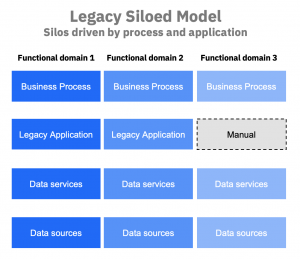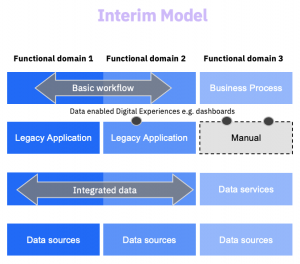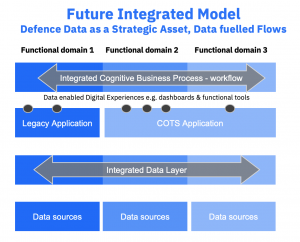Government
Defence data – a new strategic asset
8 June, 2021 | Written by: Chris Nott and Richard Davies
Categorized: Government
Share this post:
Much of defence is populated by a fragmented heritage of legacy solutions. Data, process and associated organisations are frequently siloed. This is one of the major inhibitors to realising the vision of integrating defence domains so that services can operate as one, not just nationally but in coalition.
The support chain legacy
Engineering and Asset Management (E&AM) is just one area where an integrated model is required. It endures the same fragmentation seen across defence. The schematic below illustrates silos around functional domains; domains that might be seen as different asset types or applications, for example.

Characteristics
- Siloed domains driven by an application or at best a set of applications
- No data sharing
- Swivel chair or no integration between application and process
- Stove piped organisation and behaviours
- Siloed metrics
A vertically integrated solution supporting a functional domain is insufficient to realise potential wider benefits. However, pursuit of a single solution embracing horizontal functional domains faces huge challenges in terms of cost, time to value and risk of failure.
IBM believes there is an alternative way: a framework that harnesses both legacy and new solutions, and which delivers value much quicker and in a managed transition of coordinated iterative steps at less cost and less risk.
A vision for defence with data as a strategic asset
The target future state is characterised by ‘data managed as a strategic asset’ with data-fuelled ‘flows’ of seamless and intelligent business processes. Business processes that cut across the traditional functional vertical domains to deliver value, via ‘value streams’, to the front line.
The diagram below illustrates the future model for E&AM.
Characteristics
- Siloed domains linked by end-to-end integrated processes
- Application of cognitive workflows using analytics and AI to bring insight and intelligence
- Data sharing with the engineering assets managed in a common way with a common application set where possible
- The organisation works collaboratively and is aligned to delivering end-to-end processes
- A suite of digital experiences surfaced functionality and data to meet front line user needs
- Operations managed using end-to-end value-driven performance metrics
- Complete transparency of flows
Because core elements like data and process are linked together, the solution can be seen as a ‘platform’, a platform which should:
- Leverage a diverse ecosystem of technical solutions and human skills in an orchestrated way, underpinned by coordination and governance;
- Support engineering with new digital technologies – e.g. performance dashboards and digital manuals on hand-held devices, the provenance of parts and service history recorded using blockchain, and the deployment of augmented reality to practically support engineers in their tasks;
- Embrace the Internet of Things (IoT) linking a network of sensors (within assets and linking assets), data and processing power to provide visibility and insight to inform the processes and decision-making;
- Provide a ‘digital golden thread’ of coordination across the asset life cycle from asset design, asset build to in life engineering maintenance and support to retirement;
- Enable a digital mirror of the physical world, where appropriate, through ‘digital twin’ allowing scenarios to be modelled and supported by a predictive, cognitive, automated decision-making which uses real data where possible;
- Utilise processing at the edge which increases speed and also enhances asset resilience to threats through a degree in independence;
- the realisation of a ‘Control Tower’ across all vertical functional domains providing visibility and control via a central hub. The Control Tower utilises a single operational digital dashboard for E&AM.
A fully integrated value chain
Suddenly, the realisation of a bigger picture becomes apparent, as the diagram below illustrates, where the E&AM System becomes the nucleus of an enterprise landscape underpinned by defence data managed as a strategic asset with data-fuelled flows. A single asset (and its sensors) resides in a network of assets (and their sensors), linked to the supply chain (with its sensors). The network also potentially assesses threats (picked up from sensors). It is a single, all-encompassing solution mirrored by a digital twin. This is the new digitally-enabled Support Chain; it is also realises a digitally enabled battlefield which is surely the future?

The ability to manage defence data as a strategic asset is the key enabler of this vision. IBM’s Digital Insights driven Cognitive Enterprise reference architecture is useful to frame the model because it decouples data and process from applications to enable a workflow driven perspective. It supports a services model and is solution agnostic. It presents the core underpinning of the capability to transform E&AM.

The vision is bold and compelling, but defence faces challenges around cost, complexity and risk. Therefore, capability will need to be built in incremental steps. An illustrative interim stage is presented in the diagram below, which starts to build the foundations of an E&AM and a wider vision. The foundations are driven by a standardisation and reuse of data architecture and toolsets.

Characteristics
Basic workflow starts to link processes
Core data integrated in key domains via a standard data layer solution
Gaps in capability filled by digital experiences (e.g. dashboards) that leverage integrated data
Organisation starts to be organised and managed via value-driven workflows
Value driven KPIs start to be aligned to process flow rather than functional domains
How to start the journey
The following should be explored to progress to an interim state for a E&AM System:
- Embracing agile to drive iterative development to deliver front line digital solutions or ‘experiences’;
- Working with front line command to develop user journeys showing how process, technology and data are utilitised;
- Defining a single data architecture that enables data accessibility and utility across functional domains;
- Defining an operating model that accommodates new integrated digital capabilities including governance;
- Embedding the cultural and behavioural change associated with embracing agile, starting with the leadership, and then cascading to teams;
- Deploying small projects or prototypes (e.g. digital dashboards).
We believe that a roadmap should accommodate strategic priorities and interdependencies. It would lay out key principles up front and establish a single data layer solution that can be built out. This would be used to provide insights using dashboards, modelling and simulation to inform command and control for increased tempo and adaptation by considering multiple courses of action.
Concluding thoughts
Defence is at the cusp of a paradigm shift where comprehensive, rich, networked, integrated, dynamic data becomes the fuel for workflow and performance management. It supports the digital ‘golden thread’ through the asset life cycle which is ultimately underpinned by a digital twin. In this world, agile delivery becomes a differentiator to develop value quicker and in a more responsive, customer-centric way. We have painted a compelling vision where E&AM is at the core, and it can therefore be the catalyst of transformational change.
The article was written by Richard Davies and Chris Nott. For further information, please contact your local IBM defence team or find out more about IBM’s work in defence at: https://www.ibm.com/uk-en/industries/government/defense-intelligence

Global Technical Leader for Defence & Security

Enterprise Strategy - Defence Lead IBM
Unlocking Digital Transformation in Government
As the UK government embarks on its digital transformation journey, the challenges of adopting new technologies such as artificial intelligence (AI) and data-driven solutions are becoming more evident. From managing public trust to overcoming fragmented systems, the path is complex. Blake Bower and Giles Hartwright review the unique obstacles that the government faces and […]

